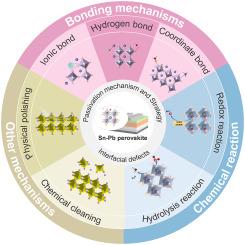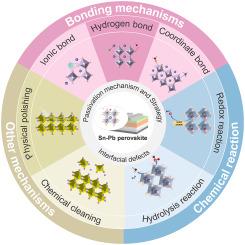Understanding and mitigating interfacial defects in tin‑lead perovskites for robust photovoltaics
IF 23.5
1区 化学
Q1 CHEMISTRY, INORGANIC & NUCLEAR
引用次数: 0
Abstract
Tin‑lead (Sn![]() Pb) hybrid perovskite solar cells (PSCs) have attracted considerable attention due to their lower bandgaps, enabling higher Shockley-Queisser (S-Q) limit efficiencies and promising applications in all-perovskite tandem solar cells. However, Sn
Pb) hybrid perovskite solar cells (PSCs) have attracted considerable attention due to their lower bandgaps, enabling higher Shockley-Queisser (S-Q) limit efficiencies and promising applications in all-perovskite tandem solar cells. However, Sn![]() Pb perovskites suffer from abundant defect states, particularly at the interfaces, which primarily stem from the chemical instability of Sn (II) and the inherent weaknesses of the crystal structure. These defects induce severe non-radiative recombination at grain boundaries/film surfaces that hinder charge transport and accelerate film degradation, ultimately limiting the device's efficiency and operational stability. This review systematically discusses the surface/interfacial defect types and their formation mechanisms in Sn
Pb perovskites suffer from abundant defect states, particularly at the interfaces, which primarily stem from the chemical instability of Sn (II) and the inherent weaknesses of the crystal structure. These defects induce severe non-radiative recombination at grain boundaries/film surfaces that hinder charge transport and accelerate film degradation, ultimately limiting the device's efficiency and operational stability. This review systematically discusses the surface/interfacial defect types and their formation mechanisms in Sn![]() Pb perovskites, followed by an in-depth analysis of defect passivation mechanisms. We further summarize the latest advancements in passivation strategies and analyze their impact on device performance. Finally, we outline key challenges and future research directions for achieving high-performance and robust Sn
Pb perovskites, followed by an in-depth analysis of defect passivation mechanisms. We further summarize the latest advancements in passivation strategies and analyze their impact on device performance. Finally, we outline key challenges and future research directions for achieving high-performance and robust Sn![]() Pb PSCs, which are crucial for shaping the evolution of next-generation perovskite photovoltaic technologies.
Pb PSCs, which are crucial for shaping the evolution of next-generation perovskite photovoltaic technologies.


了解和减轻锡铅钙钛矿中用于鲁棒光伏的界面缺陷
锡铅(SnPb)杂化钙钛矿太阳能电池(PSCs)由于其较低的带隙,具有较高的Shockley-Queisser (S-Q)极限效率,在全钙钛矿串联太阳能电池中具有广阔的应用前景。然而,SnPb钙钛矿存在丰富的缺陷态,特别是在界面处,这主要是由于Sn (II)的化学不稳定性和晶体结构的固有弱点。这些缺陷会在晶界/薄膜表面引起严重的非辐射复合,从而阻碍电荷传输并加速薄膜降解,最终限制了器件的效率和操作稳定性。本文系统地讨论了SnPb钙钛矿的表面/界面缺陷类型及其形成机制,并对缺陷钝化机制进行了深入分析。我们进一步总结了钝化策略的最新进展,并分析了它们对器件性能的影响。最后,我们概述了实现高性能和健壮的SnPb PSCs的关键挑战和未来的研究方向,这对于塑造下一代钙钛矿光伏技术的发展至关重要。
本文章由计算机程序翻译,如有差异,请以英文原文为准。
求助全文
约1分钟内获得全文
求助全文
来源期刊

Coordination Chemistry Reviews
化学-无机化学与核化学
CiteScore
34.30
自引率
5.30%
发文量
457
审稿时长
54 days
期刊介绍:
Coordination Chemistry Reviews offers rapid publication of review articles on current and significant topics in coordination chemistry, encompassing organometallic, supramolecular, theoretical, and bioinorganic chemistry. It also covers catalysis, materials chemistry, and metal-organic frameworks from a coordination chemistry perspective. Reviews summarize recent developments or discuss specific techniques, welcoming contributions from both established and emerging researchers.
The journal releases special issues on timely subjects, including those featuring contributions from specific regions or conferences. Occasional full-length book articles are also featured. Additionally, special volumes cover annual reviews of main group chemistry, transition metal group chemistry, and organometallic chemistry. These comprehensive reviews are vital resources for those engaged in coordination chemistry, further establishing Coordination Chemistry Reviews as a hub for insightful surveys in inorganic and physical inorganic chemistry.
 求助内容:
求助内容: 应助结果提醒方式:
应助结果提醒方式:


